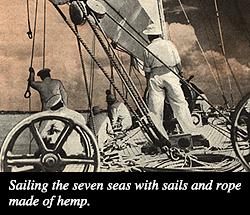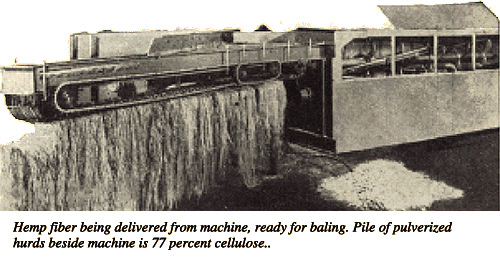|
|

 American farmers are promised a new cash crop with an
annual value of several hundred million dollars, all because a machine
has been invented that solves a problem more than 6,000 years old.
American farmers are promised a new cash crop with an
annual value of several hundred million dollars, all because a machine
has been invented that solves a problem more than 6,000 years old.
It is hemp, a crop that will not compete with other American products. Instead, it will displace imports of raw material and manufactured products produced by underpaid coolie and peasant labor and it will provide thousands of jobs for American workers throughout the land. The machine that makes this possible is designed for removing the fiber-bearing cortex from the rest of the stalk, making hemp fiber available for use without prohibitive amounts of human labor. Hemp is the standard fiber of the world. It has great tensile strength and durability. It is used to produce more than 5,000 textile products, ranging from rope to fine laces, and the woody "hurds" remaining after the fiber has been removed contain more than 77 percent cellulose, which can be used to produce more than 25,000 products, ranging from dynamite to Cellophane. Machines now in service in Texas, Illinois, Minnesota, and other states are producing fiber at a manufacturing cost of half a cent per pound, and are finding a profitable market for the rest of the stalk. Machine operators are making a good profit in competition with coolie-produced foreign fiber, while paying farmers $15 a ton for hemp as it comes from the field. From the farmer's point of view, hemp is an easy crop to grow and will yield from three to six tons per acre on any land that will grow corn, wheat, or oats. It can be grown in any state of the Union. It has a short growing season, so that it can be planted after other crops are in. The long roots penetrate and break the soil to leave it in perfect condition for next year's crop. The dense shock of leaves, eight to twelve feet above the ground, chokes out weeds. Two successive crops are enough to reclaim land that has been abandoned because of Canadian thistles or quack grass.
|
 |
|
Under old methods, hemp was cut and allowed to lie in the fields for weeks until it "retted" enough so that the fibers could be pulled off by hand. Retting is simply rotting as a result of dew, rain, and bacterial action. Machines were developed to separate the fibers mechanically after retting was complete, but the cost was high, the loss of fiber great, and the quality of fiber comparatively low. With the new machine--known as a decorticator--hemp is cut with a slightly modified grain binder. It is delivered to the machine where an automatic chain conveyor feeds it to the breaking arms at a rate of two or three tons per hour. The hurds are broken into fine pieces that drop into the hopper, from where they are delivered by blower to a baler, or to a truck or freight car for loose shipment. The fiber comes from the other end of the machine, ready for baling.
|

